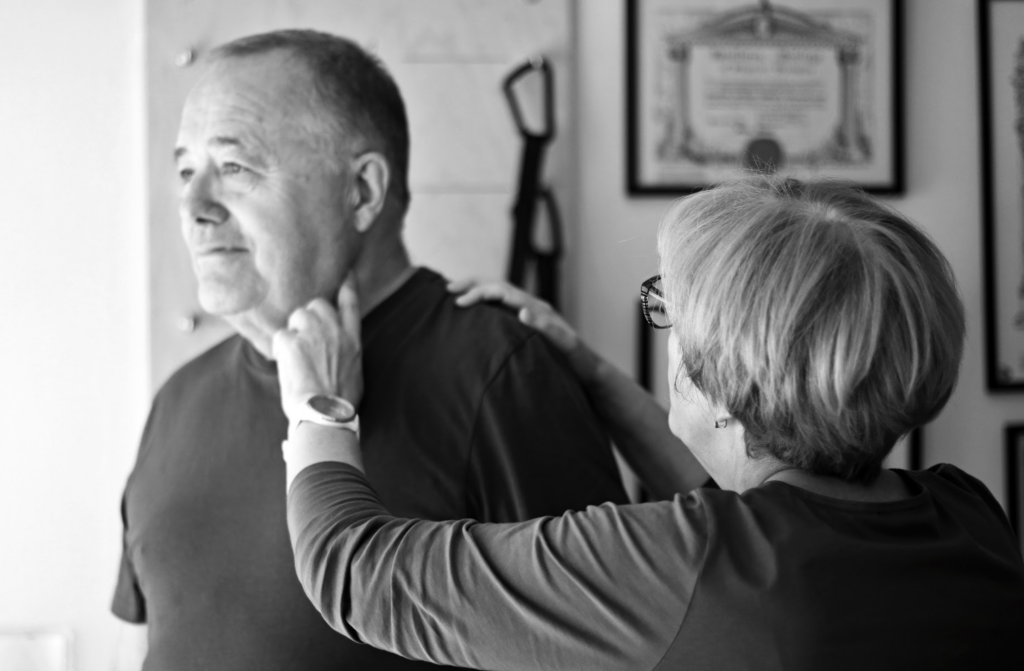 I started my career by training at the Northern Institute of Massage way back in 1991. This was a career change, and I I fell in love with treating people, helping them, which quickly developed into exploring how you enable people to wellness.
I started my career by training at the Northern Institute of Massage way back in 1991. This was a career change, and I I fell in love with treating people, helping them, which quickly developed into exploring how you enable people to wellness.
I believe assessment is so key to finding how we are going to treat and enable people to move out of their injury, from chronic pain to sports injury dysfunction.
In the beginning, I was trained by Ken Woodward, the principal Northern Institute of Massage. I was taught to see the whole body, how we treat not just one problem but something which is a part of a larger network.
Ken would say the whole body is connected, some student would enquire “how do you know?” “Where did you read this?” He would give a withering look, and reply “I don’t have to read about it! I know because I can feel it, my hands tell me the truth”. The term ‘biotensegral body’ wasn’t really in the therapist vocabulary at this moment in time, but I would now say that this is exactly what Ken was talking about.
We then went on to explore issues and dysfunction in separate areas i.e. shoulder pain, hip dysfunction, lower back pain and neck pain. The trick was not becoming so focused on the pain site, and instead to enquire how and why there is pain here. Ken would challenge us by saying “can you treat the lower back pain and still see the whole body?”
My view is that as developing therapists we almost get fixed on needing to ‘sort’ the injury, ease the pain, and most of the time the person we are treating just wants us to remove the pain, get them back running, get them back to work. We can then be influenced by their desperation to be well.
Understanding assessment became a super goal of mine. I started out aiming to completely understand ROM and angles of degrees on ROM; I wanted to be able to land mark with confidence and speed. I read Hoppenfield’s Physical Examination of the Spine and Extremities, Kendell’s Muscles, Testing & Function with Posture and Pain and Neuromusculoskeletal Examination and Assessment by Nicola J Petty & Ann P Moore.
Through all this reading I began to see that many of these assessment protocols would only test one point of the body and tell me if that was painful, without referencing that this was only a small piece of the bigger story.
We can measure a levels and ranges of movement; however, these are just little pieces of the puzzle. Can we work out compensations? Can we workout if there is a scar, adhesions or postural fatigue brought about by occupational behavior? Can we see the whole picture of what we treat first to allow the body to, for want of a better word, unravel, reverting back to be balanced so the treatment plan we create for them gives a long-lasting effect. The secret is being able to explain their treatment plan, our thoughts and knowledge in a way that makes perfect sense for them. Once on board I find they really commit to their return to well-being, and pain-free lives.
Training with Tom Hendrickson confirmed my belief we have to understand how dysfunction comes about, that the pain is only just the end of a bigger picture. Training with Tom and learning the Hendrickson Method embedded knowledge I had gained at the start of my career. His wave and soft tissue mobilisation technique gave me precise movements to make my treatment able to reach the whole body with each visit.
I became aware that my assessment began as soon as I opened the door to greet my patients. Typically, within the first 40 seconds you begin the assessment process. With students, I ask them to recreate that moment in class to trigger what the therapist is thinking back in their clinic space. The feedback is very positive and enables the therapist to have a greater understanding of how soon the assessment process begins.
For me it’s always
- Eyes
- Jaw
- How are and where are they breathing from?
Over the years it informed me of how their nervous system is resting. This is important as it can influence treatment outcome, it can be so easy to over treat a patient that has a raised sympathetic nervous system.
Over time, I gained confidence in being able to say to patients that the first treatment consultation is all about the history of the injury, and the journey your body has had over the years. The more extensive the history gives us a clearer picture on which to base a treatment plan. I explain how the body is so connected; how different parts of the body can influence injury. I go on to explain about the fascia and how it gives our body its shape, how it interweaves with the fibres, it holds us.
When I am taking a client’s history, I always go in curious, wondering, asking open questions, leaving them with the feeling that their story is super interesting, which of course, it is. Through this I discover falls in childhood that could have created compression and compensations or stickiness in the tissues and fascia, which could be impacting on the new restriction or injury.
I believe we have to listen well. I was listening to Tarana Bruke creator of the #MeToo foundation, her statement was “If you don’t hear me, you can’t see me”. It was a real moment of clarity, I thought this so well describes that moment we hear a patient’s history of their injury.
When we are chatting about their story, I ask if there are any scars no matter how old. Often patients dismiss childhood falls, bumps and scraps. I am considering where they may be in their body adding to any tethering or pulling that may have been around a long time. Here’s a list of questions I will ask, using a compassionate kind manner.
- When and how?
- How do they feel about the scar?
- Is there any sensation?
- Are they aware of it in their day-to-day life, does it pull or have tension?
- Have they ever had treatment on or around the scar?
- Is there pain or tenderness?
When it comes to the standing assessment, I like them to keep their clothes on, they stand in their comfy selves, and I believe I get a truer picture of what patterns are occurring in the body. Now more than ever I have a feeling people feel vulnerable standing in their underwear, and they hold a position that can be tight, then we get a strange untrue picture of what’s going off with in their tissues.
I like to start with the feet, if they have comfy clothes on, (I prep patients not to arrive wearing jeans). Remember soft touch, gentle hands gather more information.
- You can check for pronation or supination, and also gentle palpate the gastrocnemius – are they the same feel and density?
- Examine gently knees, hamstring, quadriceps, with an open mind, looking again at density and also size. We can pick this up all through clothing.
- Look at the pelvis and ribs; is there rotation, are there any pos/ant tilts, is there a height difference on the ilium?
- Can you see any internal or external femur rotation?
- Are there any scoliosis, kyphosis, or lordosis?
- Check their head tilt, tension within anterior neck; scalene, SCM, TMJ, how does the humerus sit in the GH joint, is there an anterior rotation?
I find gentle, positive, tactile cuing, puts the patients at ease. Once you have enabled a client to feel at ease with you, it is at this point when I feel more able to ask if I can see any scarring. I find at this stage rapport has begun and they are happy to share more openly even those who have a deeper emotional attachment to old injuries.
We begin to build a picture of the journey that the patient’s body has been on. We create a treatment plan that the patient fully understands what we are thinking. I believe if the patients truly understand our thoughts and insights their become deeper invested in the process back to wellness, owning they part they play, rehabilitation movements, dietary changes, or even committing to coming to a series of regular treatments.
When I am teaching the Hendrickson Method, or other bodywork technique workshops. I always create space to check in with our own selves. Where is our awareness of our own-selves? What drives our desire to help people?
I often share a little something that came up for me when I was in social work, especially when I have that initial consolation. It is a question that I will often ask of therapists when they attend my workshops. When we assess do we have the intent of:
- Power with
- Power to
- Power within
- Power over
I find it’s always useful to check where our ego is at when beginning to embark on assessment processes and going on to build a treatment plan.




